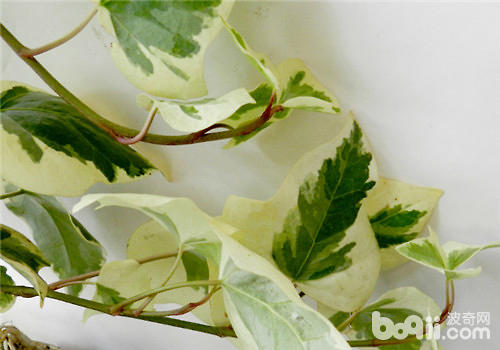How to conserve ivy
Flower and leaf ivy is a cultivated variety of ivy. This new variety of variegated leaves prefers a humid and semi-overcast environment. The requirement of fertilizer is not high, and it can grow well even if it is not fertilized for a long time. However, if fertilized too much, it will lead to its rapid growth, overgrowth, so that elegant flowers and leaves disappear, showing ordinary wild green leaves, and the loss of ornamental value. So be sure to control fertilization, when you find that there are green spotless leaves on the ivy, you can immediately remove, and stop fertilization, only watering, let it change back to flowers and leaves.
The flower-leaf ivy does not have strict lighting requirements, as long as there is a little light indoors, it can grow well indoors all the year round. Growing in semi-overcast and weak light, the coloring of flowers and leaves is more bright and beautiful.
Like to be warm, the suitable temperature for growth is 20: 25 ℃, the overwintering temperature is 5 ℃, the growing season should be well watered, and foliar spraying should be carried out frequently to make the environment moist. Pay attention to ventilation and shade in summer and change the basin every two years.
Flower and leaf ivy leaves have light green, dark green and milky white tricolor, color leaves changeable, more varieties. The leaf shape is gorgeous and lovely, and it is an excellent indoor foliage plant. No matter the vertical basin is placed on the top of the cabinet, on the viaduct, or hanging in front of the window, or climbing around the upright post in the basin can get a very good ornamental effect.
Summer conservation of flower and leaf ivy
The hot and muggy climate in summer is very disadvantageous to the growth of ivy. At this time, we should avoid the hot sun and put the plant in a cool and ventilated place indoors, or in an outdoor semi-shade place, which can make the leaves brightly colored, bright green and lovely. It stops growing from July to August when the temperature rises above 30 ℃. At this time can not because of high temperature and frequent watering, to wait for the basin soil to dry and then watering, to achieve "dry wet", at the same time should stop fertilization, so as not to scorch the leaves. Maintaining air humidity is another key to summer maintenance. Spray water 2 to 3 times a day around leaves and potted flowers to lower the temperature and increase air humidity. Flowerpots can also be placed on pots that hold water, and flowerpots are held up with tiles to separate them from water to create a suitable small environment for plant growth. In the muggy climate in summer, mosaic ivy is prone to insect pests, mainly shell insects, especially on the back of leaves and petioles. Strengthening ventilation can reduce the occurrence of insect pests. If there are few pests, you can use an old toothbrush to clean it with soapy water. In the case of many pests, it can be sprayed with 40% omethoate 800 times solution, once every seven days, 2 to 3 times in a row, and the effect is remarkable.
. Propagation methods of ivy with flowers and leaves
Mosaic ivy is a variety of ivy, so it is named because there are light green, dark green and milky white in a leaf of ivy. The adaptability of flower and leaf ivy is relatively strong, and the cultivation difficulty is not high, so cutting and striping propagation are generally used to propagate.

Flower and leaf ivy
Flower and leaf ivy can be cultured by striping method and cutting method. During striping, the branches of the same year are pressed into the soil with 2-4CM, leaves and shoots are exposed on the soil surface, and proper amount of water is sprayed every day to make them take root while growing. In the following spring, they can be transplanted in stages, and the survival rate is very high. When cutting, one-year-old branches should be taken in spring and 10-15cm in autumn, with a leaf at one end and a leaf removed and inserted into the river sand. Generally, the cuttings can take root after three weeks. If the cuttings are treated with naphthalene acetic acid of 1000 m, they will begin to grow roots in two weeks, and can be transplanted after a month, with a survival rate of 100%. The practice shows that compared with the growth of potted ivy under light and shade, the shaded plant grows better, keeps indoors all the year round, has simple management and grows well.
- Prev

How to propagate and cultivate ivy?
The leaf shape of foreign ivy is changeable, the color is rich in variety, coupled with the slender plant, chic posture, often used for hanging cultivation in front of the window, several shelves and cabinets, is a rare indoor hanging beautification plant material. Foreign ivy is native to Europe, especially in England, and enjoys a warm and humid environment.
- Next

Key points of propagation and cultivation of Ivy
Climbing or creeping growth, up to 30 meters long.
Related
- Fuxing push coffee new agricultural production and marketing class: lack of small-scale processing plants
- Jujube rice field leisure farm deep ploughing Yilan for five years to create a space for organic food and play
- Nongyu Farm-A trial of organic papaya for brave women with advanced technology
- Four points for attention in the prevention and control of diseases and insect pests of edible fungi
- How to add nutrient solution to Edible Fungi
- Is there any good way to control edible fungus mites?
- Open Inoculation Technology of Edible Fungi
- Is there any clever way to use fertilizer for edible fungus in winter?
- What agents are used to kill the pathogens of edible fungi in the mushroom shed?
- Rapid drying of Edible Fungi

